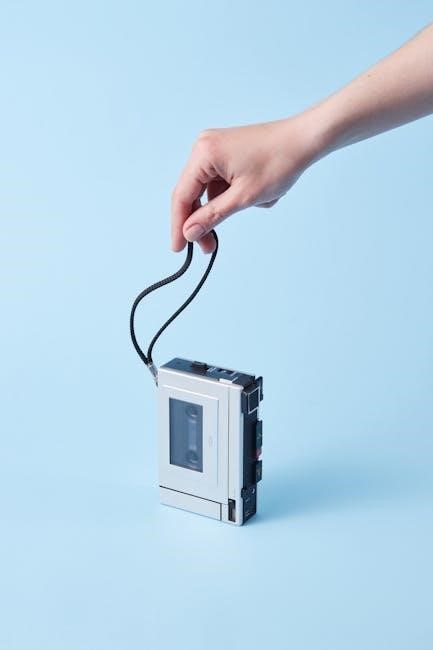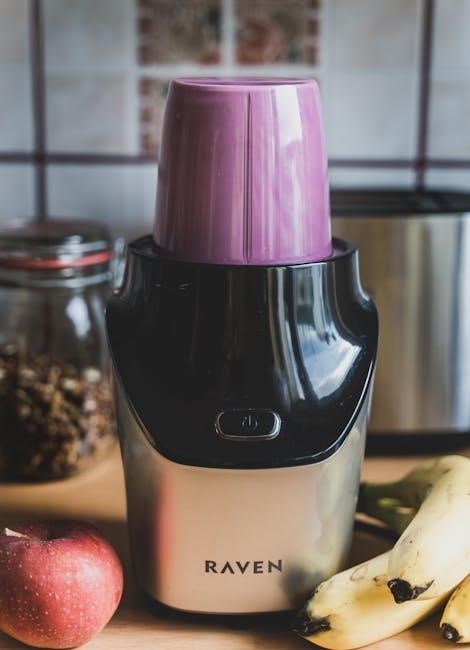Safety Information
Always read and follow safety precautions to avoid hazards. Ensure proper installation, avoid wet environments, and keep children away from movable parts. Position the unit upright and on a flat surface to prevent accidents.

1.1 General Safety Precautions
Before operating your Costway portable air conditioner, ensure you follow all safety guidelines to prevent accidents. Avoid installing or using the unit in wet environments, such as bathrooms, as this may cause electrical hazards. Always position the air conditioner on a flat, stable surface to prevent tipping. Keep children away from moving parts and ensure the unit remains upright during transportation. Never modify or tamper with the appliance, as this can lead to malfunctions. Use only genuine accessories and follow the manufacturer’s instructions for installation and operation. Proper ventilation is essential to ensure safe and efficient performance. If unsure, consult a professional. Safety first!
1.2 Important Safety Warnings
Important Safety Warnings: Ensure the portable air conditioner is placed on a flat, stable surface to prevent tipping. Avoid exposing the unit to water or moisture, as this may cause electrical hazards. Never touch the appliance’s hot parts, such as the exhaust hose or outlet, during operation. Keep flammable materials away from the unit. Always follow the manufacturer’s instructions for installation and operation. Do not modify the appliance or use unauthorized parts, as this can lead to malfunctions. Ensure proper ventilation to avoid carbon monoxide buildup. If you notice any unusual odors or noises, turn off the unit and contact customer support immediately. Always unplug the appliance during maintenance or cleaning. Follow these guidelines to ensure safe and efficient operation. Your safety is paramount.

Product Description
The Costway Portable Air Conditioner is a powerful cooling solution designed for single rooms, offering a dehumidifier, ventilation mode, and 4 operating modes for comfort.
2.1 Overview of the Costway Portable Air Conditioner
The Costway Portable Air Conditioner is a versatile and efficient cooling solution designed for single rooms. It combines portability with powerful performance, offering multiple modes such as cooling, dehumidification, and ventilation. Lightweight and compact, it is easy to move between rooms, providing consistent comfort. The unit comes with a complete window installation kit and remote control for convenient operation. Its sleek design integrates seamlessly into any home decor, making it an ideal choice for creating a comfortable atmosphere in small to medium-sized spaces. The air conditioner is energy-efficient and user-friendly, ensuring optimal performance with minimal effort.
2.2 Key Features and Benefits
The Costway Portable Air Conditioner offers a range of innovative features designed for convenience and efficiency. It includes a compact, lightweight design for easy mobility, multiple cooling modes, and a built-in dehumidifier to enhance comfort. The unit comes with a remote control for effortless operation and a complete window kit for straightforward installation. Its energy-efficient design ensures lower power consumption while maintaining high performance. Additional features like a ventilation mode and adjustable settings allow for tailored cooling solutions. These benefits make it an ideal choice for small to medium-sized spaces, providing reliable and efficient cooling with minimal effort.
2.3 Technical Specifications
The Costway Portable Air Conditioner is designed with advanced engineering, featuring a cooling capacity of 10,000 BTU (ASHRAE) or 6,000 BTU (DOE). It covers spaces up to 350 square feet, ensuring efficient cooling. The unit operates on 115V/120V power and includes a rotary compressor for smooth performance. Weighing approximately 54 pounds, it measures 28.3 inches in height, 11.8 inches in width, and 15.8 inches in depth. The airflow rate is 400 CFM, and the exhaust hose is 4 feet long. It also features a 5-foot power cord and a dehumidification capacity of up to 2.6 pints per hour. The energy efficiency ratio (EER) is 8.9, ensuring energy-saving operation.

Installation and Setup
Begin by unpacking all parts and verifying inventory. Follow step-by-step instructions for proper assembly and installation. Ensure the unit is placed upright on a flat surface.
3;1 Unpacking and Inventory of Parts
Begin by carefully unpacking the portable air conditioner and all included accessories. Ensure the unit is upright during unpacking to prevent damage. Check for any visible damage or missing components. Verify the inventory against the parts list in the manual, ensuring all items are accounted for. This includes the main unit, remote control, window kit, venting hose, and installation hardware. Handle the unit with care to avoid scratches or dents. Organize the parts neatly to avoid misplacement. If any parts are missing or damaged, contact customer support immediately for assistance. Proper organization ensures a smooth installation process.
3.2 Step-by-Step Installation Guide

Start by positioning the air conditioner on a flat, stable surface away from direct sunlight. Attach the C-shaped buckle to the exhaust hose and secure it to the unit. Next, assemble the window kit according to the instructions, ensuring all parts fit snugly. Connect the venting hose to the unit and the window kit, making sure it is tightly sealed. Plug in the power cord and ensure all connections are secure. Finally, turn on the unit and test all functions to confirm proper operation. Follow the manual’s detailed steps for a seamless setup.
3.3 Window Kit Installation
For proper installation, choose an accessible window and ensure the kit fits within its dimensions. Attach the adjustable bracket to the window frame using screws to secure it. Snap the venting hose into place on the bracket, ensuring a tight seal. Connect the other end of the hose to the air conditioner unit firmly. Use provided foam strips to seal any gaps around the window for optimal cooling efficiency. Finally, test the setup by running the unit to confirm the venting system is working correctly, ensuring hot air is directed outside without leaks.
3.4 Venting and Exhaust Hose Setup
Connect the exhaust hose to the air conditioner unit securely to ensure proper ventilation. Extend the hose straight without kinks to avoid restricting airflow. Place the hose through the window kit adapter, ensuring a snug fit. Use foam strips to seal any gaps around the hose for optimal efficiency. Direct the hose outside to vent hot air away from the room. Avoid bending or coiling the hose, as this can reduce performance. After setup, turn on the unit to verify that exhaust airflow is smooth and unobstructed. Proper venting is crucial for efficient cooling and safe operation of the portable air conditioner.

Operating the Unit
Operate the unit by using the control panel or remote to select modes and adjust settings. Ensure settings are optimal for your room size and refer to specific sections for detailed guidance.
4.1 Controls and Modes of Operation
The Costway portable air conditioner features a user-friendly control panel and remote for easy operation. It offers multiple modes, including Cool, Fan, and Dry, to suit different needs. The Cool mode allows for precise temperature adjustment, while the Fan mode circulates air without cooling. The Dry mode removes excess moisture from the room. Use the remote to adjust settings conveniently. The control panel includes buttons for mode selection, temperature adjustment, and fan speed control. Ensure the unit is set to the correct mode for optimal performance and energy efficiency. Always refer to the manual for specific guidance on operating the unit effectively.
4.2 Using the Remote Control
The remote control allows for convenient operation of the Costway portable air conditioner. It features buttons for adjusting temperature, fan speed, and mode selection. To use the remote, ensure it is within range of the unit and free from obstructions. Batteries (usually AA or AAA) must be installed correctly for proper function. Use the remote to switch between Cool, Fan, and Dry modes. Adjust temperature settings using the up and down arrows. The remote also allows you to activate the timer and adjust fan speed for personalized comfort. Always keep the remote dry and avoid exposing it to extreme temperatures.
4.3 Adjusting Temperature and Settings
To adjust the temperature, use the remote control or the unit’s control panel. Set your desired temperature between 61°F and 90°F using the up and down arrows. The air conditioner will automatically adjust to maintain the set temperature. Choose from Cool, Fan, or Dry modes based on your needs. In Cool mode, the unit will actively lower the temperature. Fan mode circulates air without cooling, while Dry mode removes excess moisture. Adjust fan speed (Low, Medium, High) for optimal comfort. Use the timer function to set operation duration. Allow the unit time to adjust after changes for consistent performance. Refer to the remote control section for additional guidance.
4.4 Energy Efficiency Tips
To maximize energy efficiency, set the temperature between 73°F and 78°F, as this range uses less energy while maintaining comfort. Use the timer function to turn off the unit when not needed. Close doors and windows to keep cooled air inside. Regularly clean the air filter to ensure optimal performance. Use the dehumidifier mode instead of cool mode when dehumidification is the primary need. Place the unit in the center of the room for even air distribution. Avoid direct sunlight on the unit to reduce heat intake. These tips help lower energy consumption while maintaining effective cooling performance. Refer to the manual for additional eco-friendly operation guidance.

Maintenance and Care
Regularly clean the air conditioner to ensure efficiency. Check and replace filters as needed. Ensure proper drainage to prevent water buildup. Schedule professional maintenance annually for optimal performance.
5.1 Cleaning the Air Conditioner
To maintain efficiency and hygiene, clean the unit regularly. Turn off and unplug the air conditioner before cleaning. Wipe the exterior with a soft cloth and mild detergent. Clean the air filter by rinsing it with warm water or replacing it if damaged. Check and clean the evaporator and condenser coils to ensure proper airflow. Drain the water tank regularly to prevent mold buildup. For stubborn dirt, use a gentle brush or vacuum on low settings. Avoid harsh chemicals or abrasive materials that may damage the unit. Regular cleaning ensures optimal performance and extends the lifespan of your portable air conditioner.
5.2 Filter Maintenance
Regular filter maintenance is crucial for optimal performance. Turn off the unit and unplug it before handling the filter. Remove and rinse the filter with warm water to eliminate dust and debris. Allow it to dry completely before reinstalling. If the filter is damaged, replace it immediately to ensure proper airflow and efficiency. Clean the filter every two weeks or more frequently in dusty environments. A well-maintained filter improves air quality, reduces energy consumption, and prolongs the lifespan of your Costway portable air conditioner; Always refer to the manual for specific filter replacement guidelines if necessary. This simple maintenance step ensures consistent cooling performance and better indoor air quality; By keeping the filter clean, you also prevent potential issues like reduced airflow or increased noise levels. Regular checks and timely cleaning are essential for maintaining your unit’s efficiency and effectiveness. Remember, a clean filter not only enhances performance but also contributes to a healthier living environment. Always handle the filter with care to avoid damage and ensure it fits securely back into place. This maintenance routine is quick and easy, making it a vital part of your air conditioner’s upkeep. Keep your filter in top condition to enjoy uninterrupted cooling comfort throughout the year. Regular maintenance also helps in identifying any potential issues early, preventing more severe problems from developing. By prioritizing filter care, you can ensure your Costway portable air conditioner operates at its best, providing reliable and efficient cooling when you need it most. This attention to detail will not only save you time and money but also ensure your unit remains a trusted companion for years to come. Always remember, a clean filter is the key to a happy and healthy cooling system. So, make filter maintenance a regular part of your routine and enjoy the benefits of a well-functioning air conditioner. Never underestimate the importance of this simple yet critical task. Your unit—and your comfort—will thank you. Regular filter maintenance is an essential step in preserving the performance and longevity of your Costway portable air conditioner. By following these guidelines, you can ensure your unit continues to deliver exceptional cooling and maintain a clean, healthy indoor environment. Keep your filter clean, and your air conditioner will keep you cool and comfortable all season long.
5.3 Troubleshooting Common Issues
If your Costway portable air conditioner isn’t cooling, check if the filter is clean or if the room is properly sealed. Ensure the drain hose is correctly installed to prevent water leakage. If the unit displays an error code, refer to the manual for specific solutions. For noise issues, ensure the unit is level and all parts are securely tightened. If the remote control isn’t working, replace the batteries or check for signal blockages. Regularly cleaning the filter and ensuring proper ventilation can resolve many common issues. Always unplug the unit before performing any troubleshooting steps. For persistent problems, contact Costway support for assistance. Proper maintenance and timely issue resolution will ensure your air conditioner operates efficiently and effectively.

Additional Features
- Dehumidifier function for reducing moisture in the air.
- Ventilation mode to circulate and refresh indoor air.
- Remote control for convenient operation.
- Multiple cooling modes for customized comfort.
6.1 Dehumidifier Function
The Costway Portable Air Conditioner features a built-in dehumidifier function, designed to remove excess moisture from the air. This function enhances cooling efficiency and improves indoor air quality. By reducing humidity, it prevents mold growth and creates a more comfortable environment. The dehumidifier mode can be activated independently of cooling, making it useful in damp conditions. Water collected during dehumidification is stored in the unit’s drainage tank, which must be emptied regularly for optimal performance. This dual functionality makes the unit versatile for various weather conditions, ensuring your space remains cool and dry year-round.
6.2 Ventilation Mode
The Costway Portable Air Conditioner’s ventilation mode allows for continuous air circulation, enhancing indoor air quality without cooling. This mode is ideal for maintaining a fresh atmosphere, especially in well-insulated spaces. Activating ventilation mode helps exchange stale indoor air with fresh outdoor air through the venting system. Use this mode during mild weather when cooling isn’t needed, but air circulation is desired. It operates quietly and efficiently, contributing to a comfortable environment. Ensure the unit is properly vented to outdoor spaces for optimal performance in ventilation mode.
Thank you for choosing the Costway Portable Air Conditioner. Proper use and maintenance ensure optimal performance. Refer to this manual for any future questions or concerns.

7.1 Final Tips for Optimal Performance
To ensure your Costway Portable Air Conditioner performs at its best, follow these tips:
- Always install the window kit correctly to prevent hot air recirculation.
- Ensure the exhaust hose is properly connected and unobstructed.
- Clean the air filter regularly to maintain airflow and efficiency.
- Operate the unit on a flat, stable surface to avoid tilting.
- Monitor the humidity level when using the dehumidifier function.
- Adjust temperature settings wisely to balance comfort and energy use.
- Refer to the manual for troubleshooting common issues promptly.
By following these guidelines, you can enjoy reliable cooling and extend the lifespan of your unit.
7.2 Contact Information for Support
For any inquiries, concerns, or assistance with your Costway Portable Air Conditioner, please contact our support team:
- US: email160;protected
- UK: email160;protected
- AU: email160;protected
- Visit our website: www.costway.com for additional support resources.
Our team is ready to assist with troubleshooting, replacement parts, or general questions about your product. Please do not return items without contacting us first.

FAQs
Frequently asked questions about the Costway Portable Air Conditioner include queries about installation, operation, and troubleshooting. Visit our support page for detailed answers.
8.1 Frequently Asked Questions
Users often inquire about common issues like water leakage, noise levels, and remote control functionality. For leakage, ensure proper drain hose installation. Noise issues may arise if the unit is unlevelled. If the remote isn’t working, check battery alignment and sensor cleanliness. For optimal performance, maintain a clean air filter and ensure proper venting. If issues persist, refer to the troubleshooting guide or contact customer support for assistance. Always follow the manual’s guidelines for installation and maintenance to avoid operational problems. Visit our support page for detailed solutions and FAQs.
8.2 Common User Queries
Many users ask about proper installation techniques, with a focus on window kit assembly and drain hose setup. Others inquire about noise reduction methods, such as placing the unit on a leveled surface or using noise-reducing pads. Some seek advice on optimizing cooling performance, like ensuring proper venting and maintaining a clean air filter. Additionally, questions arise about the dehumidifier function, with users wanting to know how to manage water collection and drainage effectively. For remote control issues, checking battery alignment and ensuring sensor cleanliness often resolve problems. Always refer to the manual for detailed guidance on these topics.